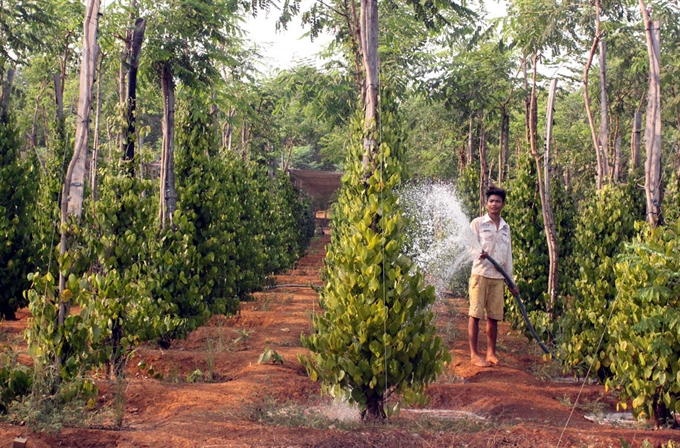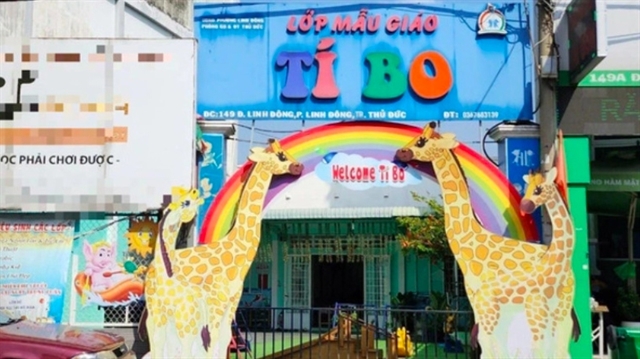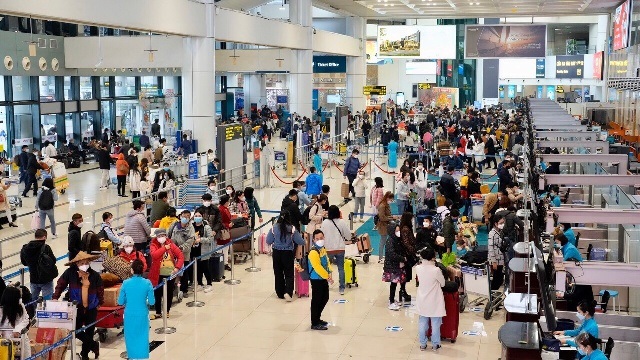.jpg) Society
Society

Farmers in the Cửu Long (Mekong) Delta’s areas affected by saline intrusion have been urged to switch to other crops or breed shrimp or fish. Experts have said that farmers in these areas should gradually adapt to saline-water cultivation models.
 |
| Farmers water pepper trees in Hưng Phước Commune, Bù Đốp District, in the southern Ninh Thuận Province. Farmers in the Cửu Long (Mekong) Delta that have been affected by saline intrusion were urged to switch to other crops or breed shrimp or fish. — VNA/VNS Photo |
HCM CITY – Farmers in the Cửu Long (Mekong) Delta’s areas affected by saline intrusion have been urged to switch to other crops or breed shrimp or fish.
Experts have said that farmers in these areas should gradually adapt to saline-water cultivation models.
Professor Võ Tòng Xuân, one of Việt Nam’s leading agriculture experts, said in coastal areas affected by saline intrusion, farmers should switch from growing only rice crops year-round and instead grow one rice crop in the rainy season and breed shrimp or fish in the dry season.
Sóc Trăng Province’s Mỹ Xuyên District has implemented a rice-shrimp cultivation model and earned a profit of four to five times higher than that from rice, he said.
Under this model, farmers grow rice in the rainy season and let saline water enter rice fields to breed shrimp in the dry season.
“Other coastal districts have also implemented this model and got high profits,” he said.
The model is considered suitable for the Government’s plan to restructure agriculture and convert ineffective rice fields into crops that yield higher profits, he said.
The country needs only one million hectares of rice to produce enough rice for domestic demand, he said.
The delta grows about 1.53 million hectares of winter-spring rice this year.
Xuân said the delta should not pursue growing rice for exports at cheap prices as farmers will not make high profits.
If farmers can breed shrimp sustainably in saline-intrusion areas, the Government should invest in irrigation systems for shrimp cultivation to prevent diseases, he said.
In the delta, saline intrusion usually occurs in the dry season.
Professor Nguyễn Văn Sánh, head of the Cửu Long Delta Research and Development Institute, said the season of saline intrusion should be exploited by taking advantage of saline water-cultivation models similar to those in coastal areas.
He said the delta should discontinue building dams and sluice gates designed to prevent saline intrusion.
In Kiên Giang Province, the country’s largest rice producer, rice farmers have built dams to keep fresh water while shrimp farmers take saline water into fields to breed shrimp, causing conflicts between rice and shrimp farmers.
Nguyễn Văn Tâm, director of the Kiên Giang Province’s Department of Agriculture and Rural Development, said it was time to identify areas suited to rice, brackish-water aquaculture and saline-water aquaculture.
Forecasting
Tô Văn Trường, former head of the Southern Irrigation Planning Institute, said forecasting was needed to predict saline intrusion.
If local authorities and the public have information three to six months in advance, they will restructure their crops and avoid losses, he said.
Saline intrusion can be predicted without the need to have complicated forecasting facilities, he said.
In the Long Xuyên Quadrangle and Đồng Tháp Mười (Plain of Reeds) regions, for instance, floodwater is usually two to three meters high in the flooding season.
Floodwater in the regions was only knee-high in the last flooding season, with saline intrusion entering deep inland in coastal areas in the dry season this year.
To avoid damage from saline intrusion, local authorities should urge people in coastal areas by not growing the winter-spring rice.
Saline intrusion in the delta occurred nearly two months earlier this year.
In many areas, saline water has entered 70-90km deep inland, 15-20km deeper than the average of many years.
The delta’s ongoing saline intrusion has affected nearly 160,000ha of rice since the end of last year, according to the Ministry of Agriculture and Rural Development.
Mai Thành Phụng, former head of the Southern Agriculture Extension Centre, said many cultivation models could help farmers earn higher profits than rice.
However, decisions need to be made about where cultivation models should be located, and how to make them effective and profitable.
Phụng said agriculture companies need to invest more in these models.
The capital invested in agriculture has accounted for only one per cent of the total capital that companies have invested in all sectors, he said.
“The Government’s responsibility is to boost the investment of companies in the agricultural sector to increase to 5 – 10 per cent in coming years,” he said.
Unstable prices
Speaking at a seminar held in Cần Thơ last week, many farmers said they wanted to diversify their crop cultivation, but their produce does not have stable prices.
The price of high quality rice and normal quality price are similar, they said.
Professor Bùi Chí Bửu of the Southern Agricultural Science Institute said the agricultural sector has not had solutions to find markets for farmers over the years.
To have markets, it needs the participation of companies, he said, adding that the delta does not have large-scale specialised cultivating areas to produce exports in bulk.
Đồng Tháp Province, for instance, had developed soybean cultivation areas to 11,000ha in the past but the area has reduced to 600ha because the price of soybeans is not attractive.
Võ Hùng Dũng, director of the Việt Nam Chamber of Commerce and Industry’s Cần Thơ Branch, said to have markets the Government should play a decisive role in investing in infrastructure to help farmers make decisions on what to grow. – VNS



.jpg)




.jpg)
